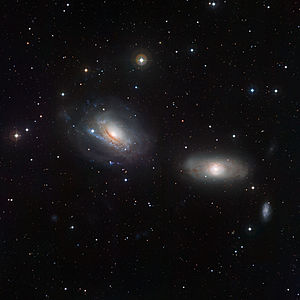NGC 3165
| Galaxie NGC 3165 | |
|---|---|
 | |
| NGC 3165 (klein, rechts unten) neben NCG 3166 (rechts) und NGC 3169 (links) aufgenommen mit dem Wide Field Imager des MPG/ESO 2.2-Meter Teleskop im La-Silla-Observatorium. | |
| AladinLite | |
| Sternbild | Sextant |
| Position Äquinoktium: J2000.0, Epoche: J2000.0 | |
| Rektaszension | 10h 13m 31,3s[1] |
| Deklination | +03° 22′ 30″[1] |
| Erscheinungsbild | |
| Morphologischer Typ | Sdm[1] |
| Helligkeit (visuell) | 13,9 mag[2] |
| Helligkeit (B-Band) | 14,5 mag[2] |
| Winkelausdehnung | 1,3′ × 0,7′[2] |
| Positionswinkel | 177°[2] |
| Flächenhelligkeit | 13.6 mag/arcmin²[2] |
| Physikalische Daten | |
| Zugehörigkeit | LGG 192[3] |
| Rotverschiebung | 0.004370 ± 0.000010[1] |
| Radialgeschwindigkeit | (1310 ± 3) km/s[1] |
| Hubbledistanz H0 = 73 km/(s • Mpc) | (53 ± 4) · 106 Lj (16,1 ± 1,1) Mpc [1] |
| Durchmesser | 20.000 Lj[4] |
| Geschichte | |
| Entdeckung | R. J. Mitchell |
| Entdeckungsdatum | 30. Januar 1856 |
| Katalogbezeichnungen | |
| NGC 3165 • UGC 5512 • PGC 29798 • CGCG 036-063 • MCG +01-26-23 • Holm 173C | |
NGC 3165 ist eine spiralförmige Zwerggalaxie vom Hubble-Typ Sdm im Sternbild Sextant am Südsternhimmel, die schätzungsweise 53 Millionen Lichtjahre von der Milchstraße entfernt ist. Sie interagiert mit den Galaxien NGC 3166 und NGC 3169, wie in dem rechten Bild zu sehen ist.
Das Objekt wurde am 30. Januar 1856 vom irischen Astronomen R. J. Mitchell, einem Assistenten von William Parsons, entdeckt.[5]
Literatur
- König, Michael & Binnewies, Stefan (2019): Bildatlas der Galaxien: Die Astrophysik hinter den Astrofotografien, Stuttgart: Kosmos, S. 233
Weblinks
Einzelnachweise
Auf dieser Seite verwendete Medien
Autor/Urheber: ESO/Igor Chekalin, Lizenz: CC BY 4.0
This image from the Wide Field Imager on the MPG/ESO 2.2-metre telescope at the La Silla Observatory in Chile captures the pair of galaxies NGC 3169 (left) and NGC 3166 (right). These adjacent galaxies display some curious features, demonstrating that each member of the duo is close enough to feel the distorting gravitational influence of the other. The gravitational tug of war has warped the spiral shape of one galaxy, NGC 3169, and fragmented the dust lanes in its companion NGC 3166.
